Update Scenario
For each of our Scenarios we will need to configure the relevant Messages & Fields. This scenario will need to be tested before moving on to the next.
The Messages we shall be configuring for our Update Scenario are:
Receipt
UpdateIncident
We will define which Field records require configuring for each of those Messages at the appropriate time.
The scenario will need to be successfully tested before we can say it is complete.
We shall look in detail at each of the Messages and their respective Fields in turn over the next few pages, before moving on to Test.
Receipt MessageUpdateIncident MessageUpdateIncident FieldsTest UpdateIncidentReceipt Message
The Receipt Message is the asynchronous receipt that is sent after processing update type messages.
Again, after clicking the 'Messages' icon, you are directed to the following screen (note: the three previously configured messages are now visible in the list):
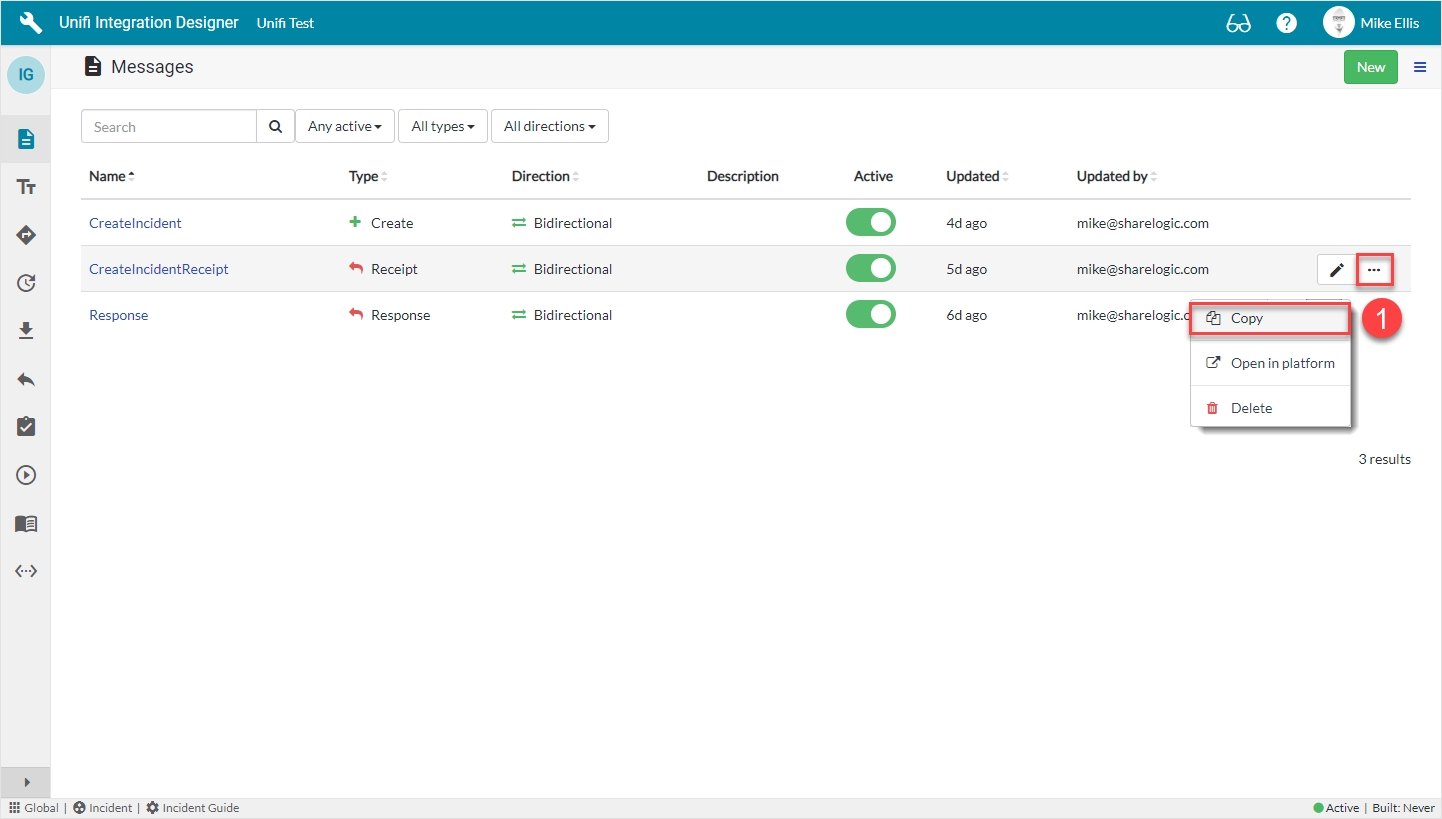
Click on the ellipsis to the right of the CreateIncidentReceipt Message & click Copy.
Rather than create the Receipt Message from scratch, it will be quicker to copy the CreateIncidentReceipt Message and make one minor change.
Copy Message Modal
The fields to edit for the Copy Message modal are as follows:
Message name
The message name that is unique for this integration.
'Receipt'
Your Copy Message modal should look like this:
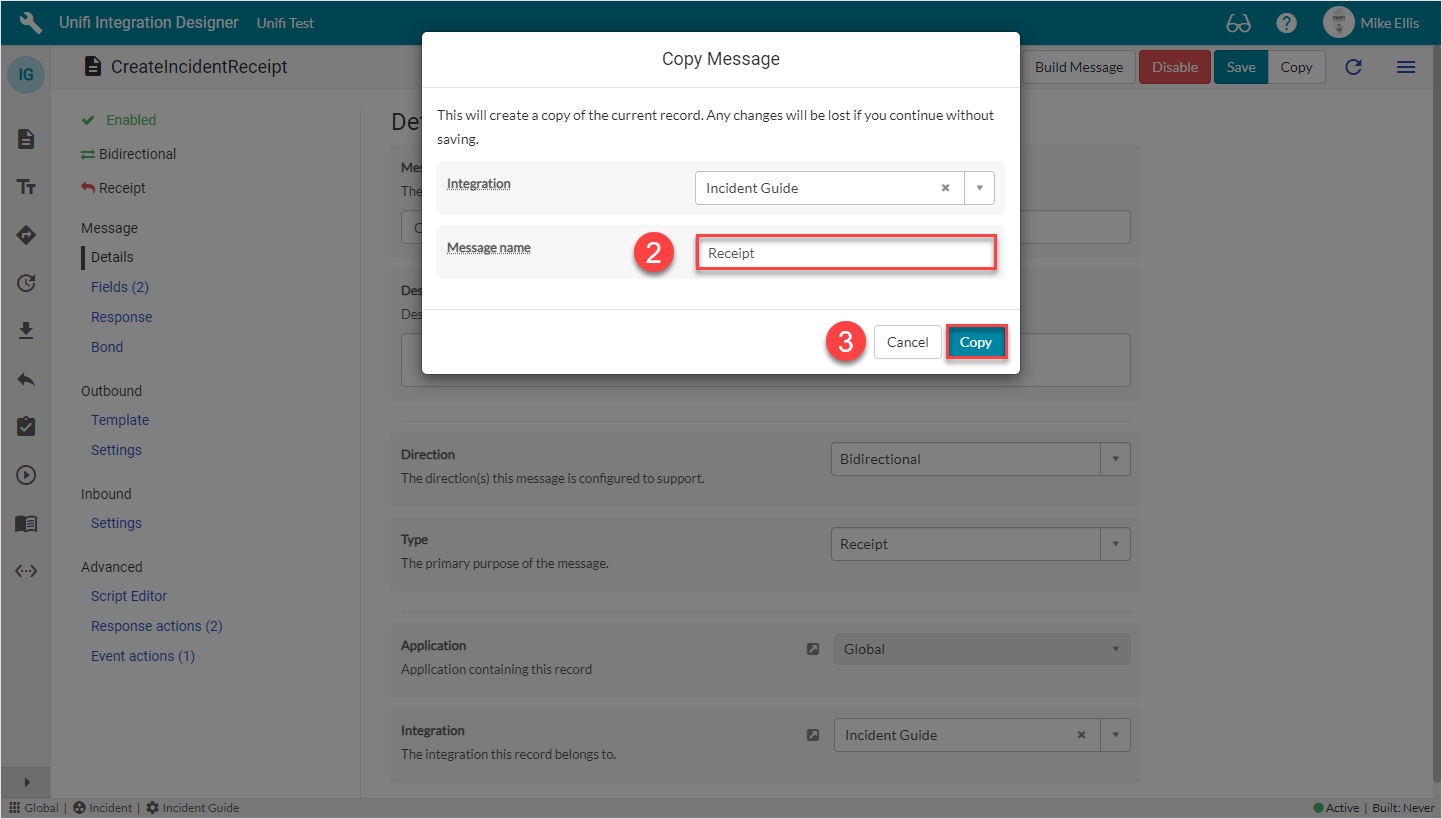
Click Copy.
You will be redirected to the Details page of the newly created Receipt Message.
Bond Fields
Navigate to Message > Bond.
The Bond fields to be edited are as follows:
Set bond state inbound*
Set the Bond State when receiving this message. Use 'None' to leave the Bond State alone or to modify it via a Message/Field Stage to Target script.
'None'
Your Bond form should look like this:
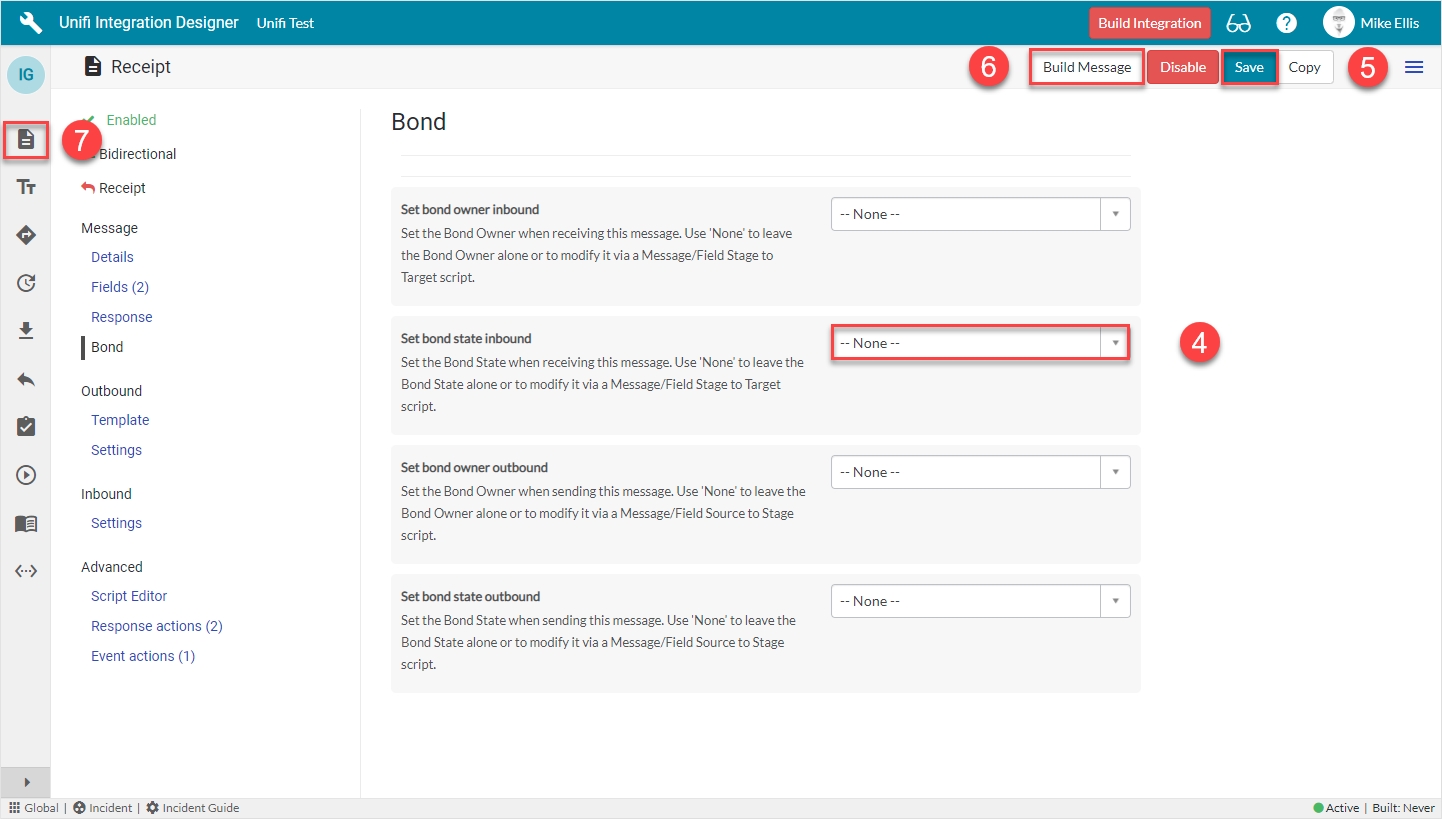
Click Save.
Click Build Message.
You will see the 'Message build successful' Info Message.

Click the 'Messages' icon to move on & configure the UpdateIncident Message.
UpdateIncident Message
The UpdateIncident Message is an update type message that sends updates to the bonded record.
Again, after clicking the 'Messages' icon, you are directed to the following screen (note: the four previously configured messages are now visible in the list):
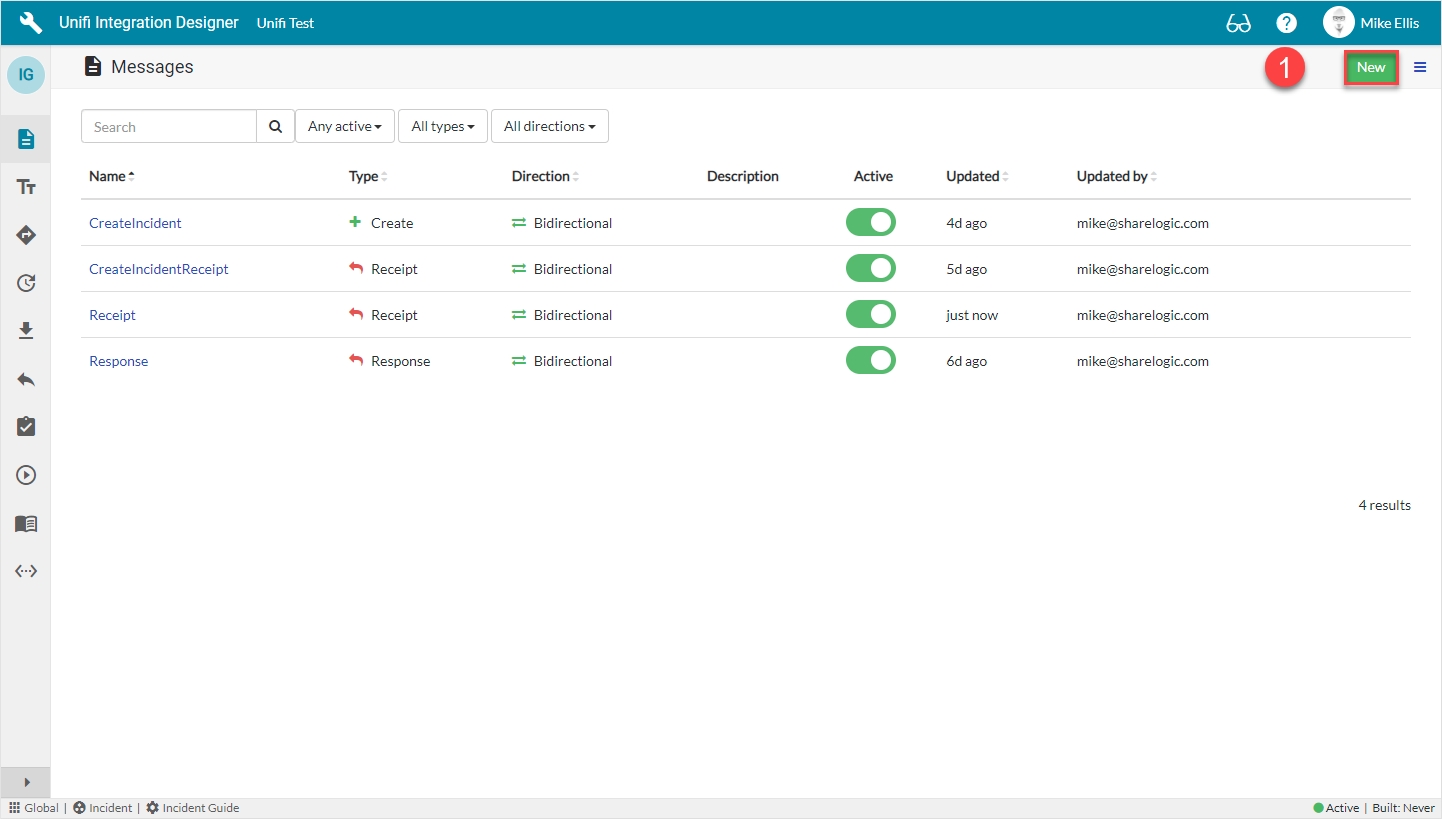
Click New.
New Message Modal
The fields to be configured for the UpdateIncident New Message modal are as follows:
Message name
The message name that is unique for this integration.
'UpdateIncident'
Type
The primary purpose of the message.
'Update'
Direction
The direction(s) this message is configured to support.
'Bidirectional'
Your UpdateIncident New Message modal should look like this:
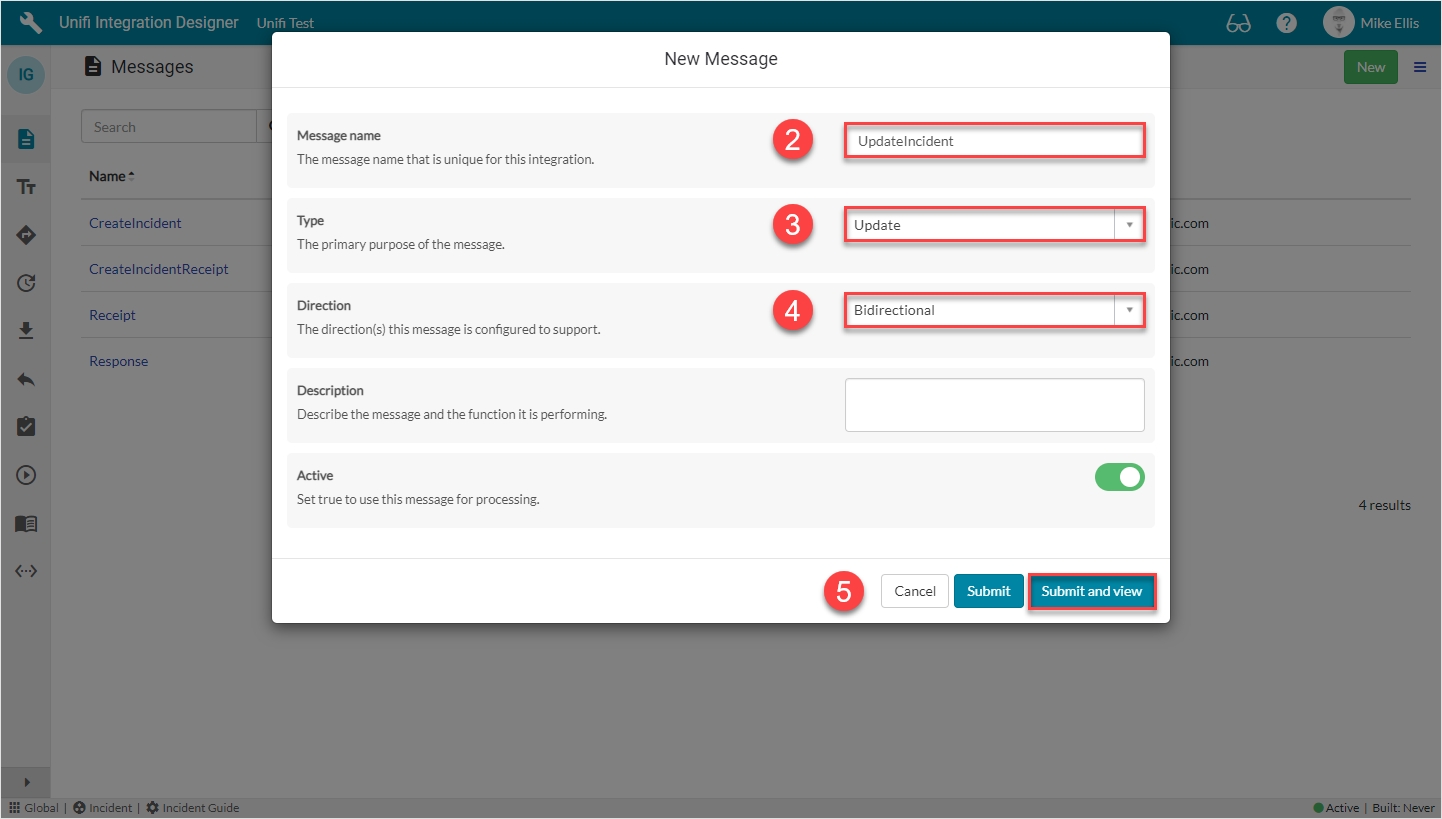
Submit and view to further configure the Message.
Response Fields
Navigate to Message > Response.
The Response fields to be configured are as follows:
Response
The immediate synchronous response to this message.
lookup: 'Response'
Async*
Turn this option on if you want inbound processing to occur asynchronously or this message is the first of an asynchronous message pair.
<true>
Async receipt
The asynchronous receipt to this message.
lookup: 'Receipt'
*This field is automatically defaulted to true.
Your Response form should look like this:
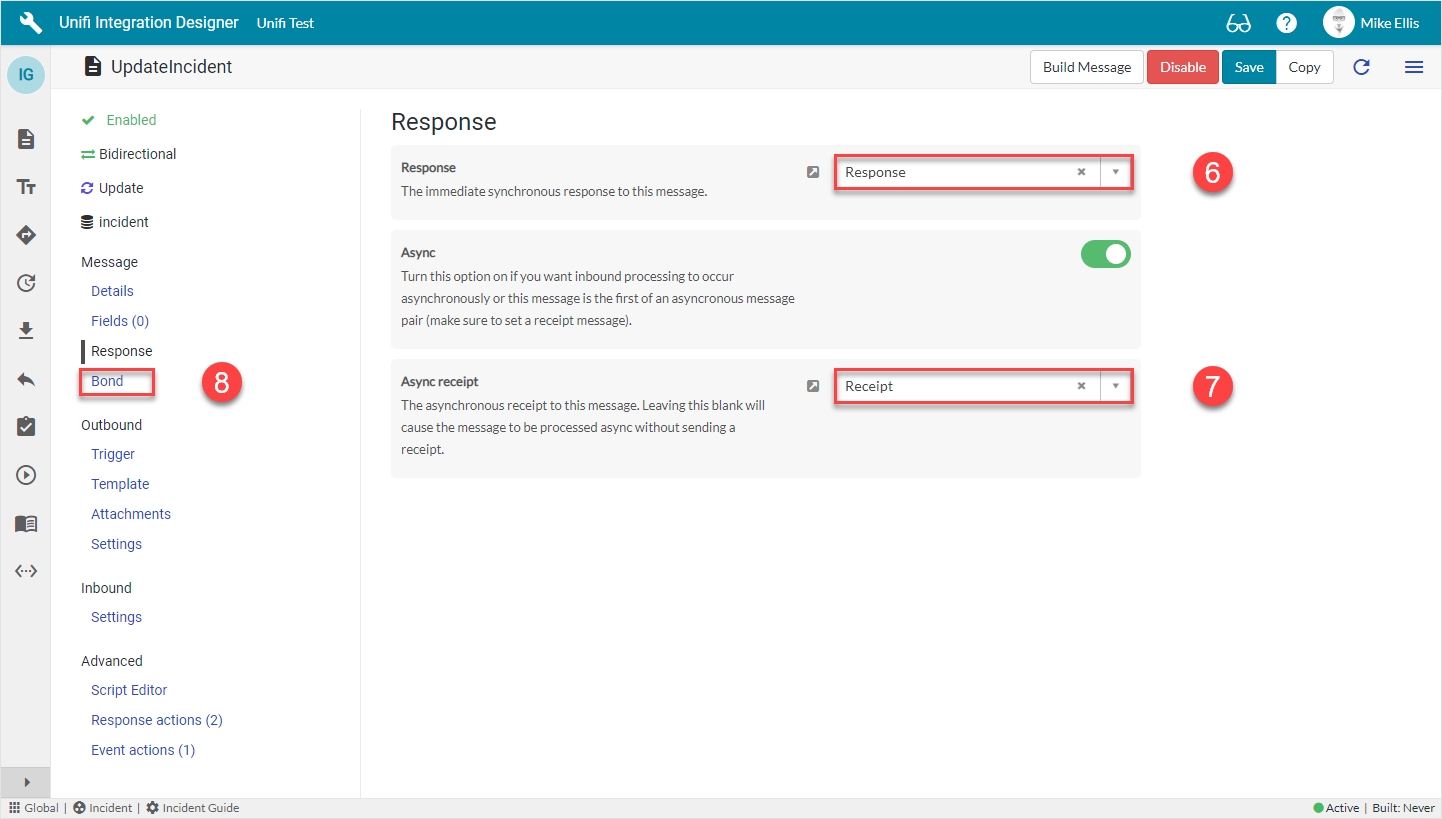
Navigate to Message > Bond.
Bond Fields
The Bond fields to be configured are as follows:
Bond ownership*
Determine if the sender should own the bond or not in order for this message to be processed? Use 'Ignore' to process regardless of the owner flag. (Choices: Ignore, Must own, Must not own.)
'Ignore'
Bond condition type*
The type of conditional check made on the bond. (None: no checks are made. State: checks against the state are made using the conditional checkboxes. Scripted: the 'Bond condition' script is used.)
'State'
Bond pending
Process this message when the bond state is Pending.
<true>
Bond open
Process this message when the bond state is Open.
<true>
*These fields are automatically populated.
Your Bond form should look like this:
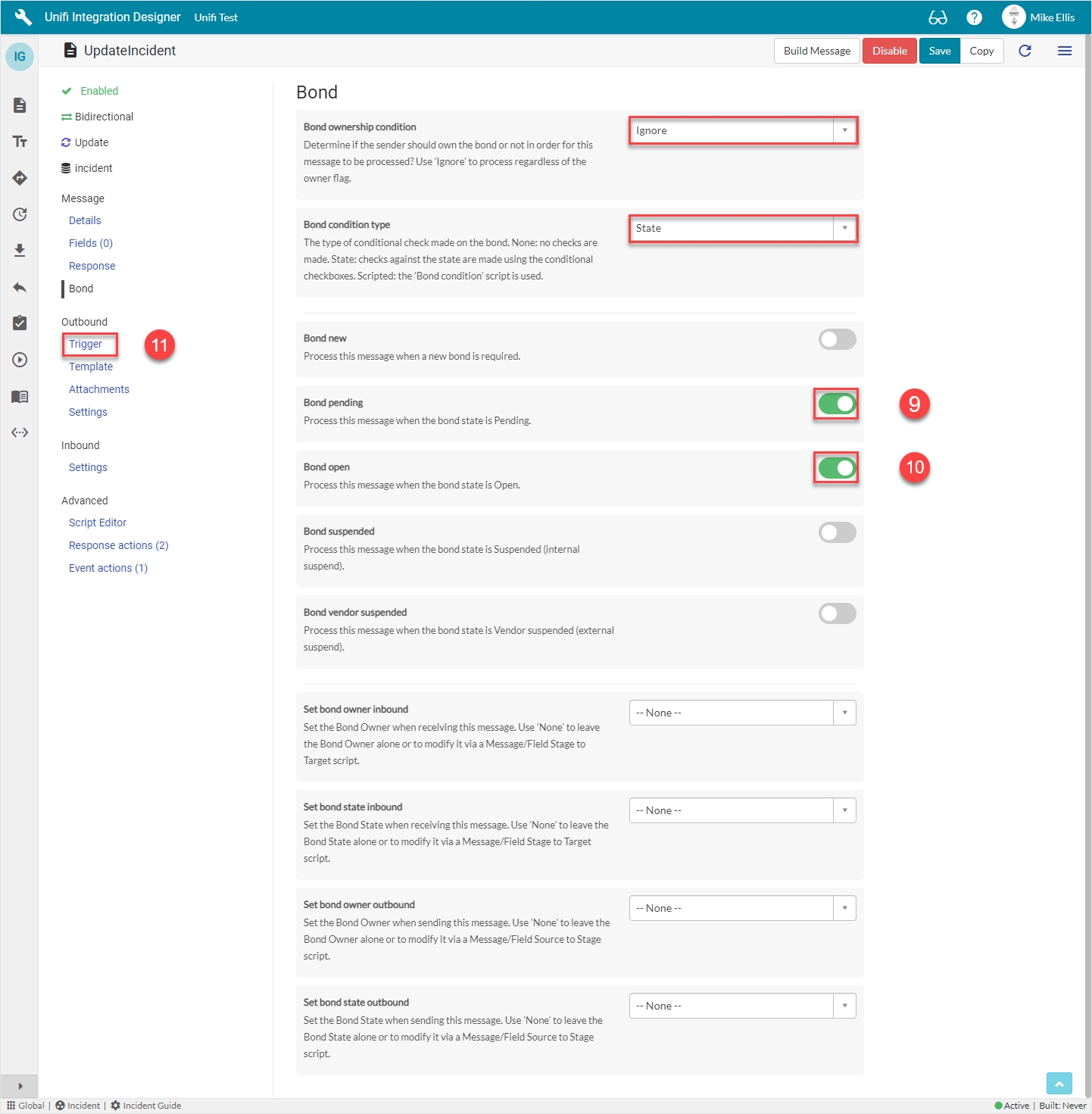
Navigate to Outbound > Trigger.
Outbound Trigger Fields
The Outbound Trigger fields to be configured (as required)* are as follows:
Outbound condition*
The condition that the ServiceNow record must meet to trigger this message being processed.
Update the Outbound condition script field with the code below
The code in the 'Outbound condition' script field should look like this:
Your Outbound Trigger form should look like this:
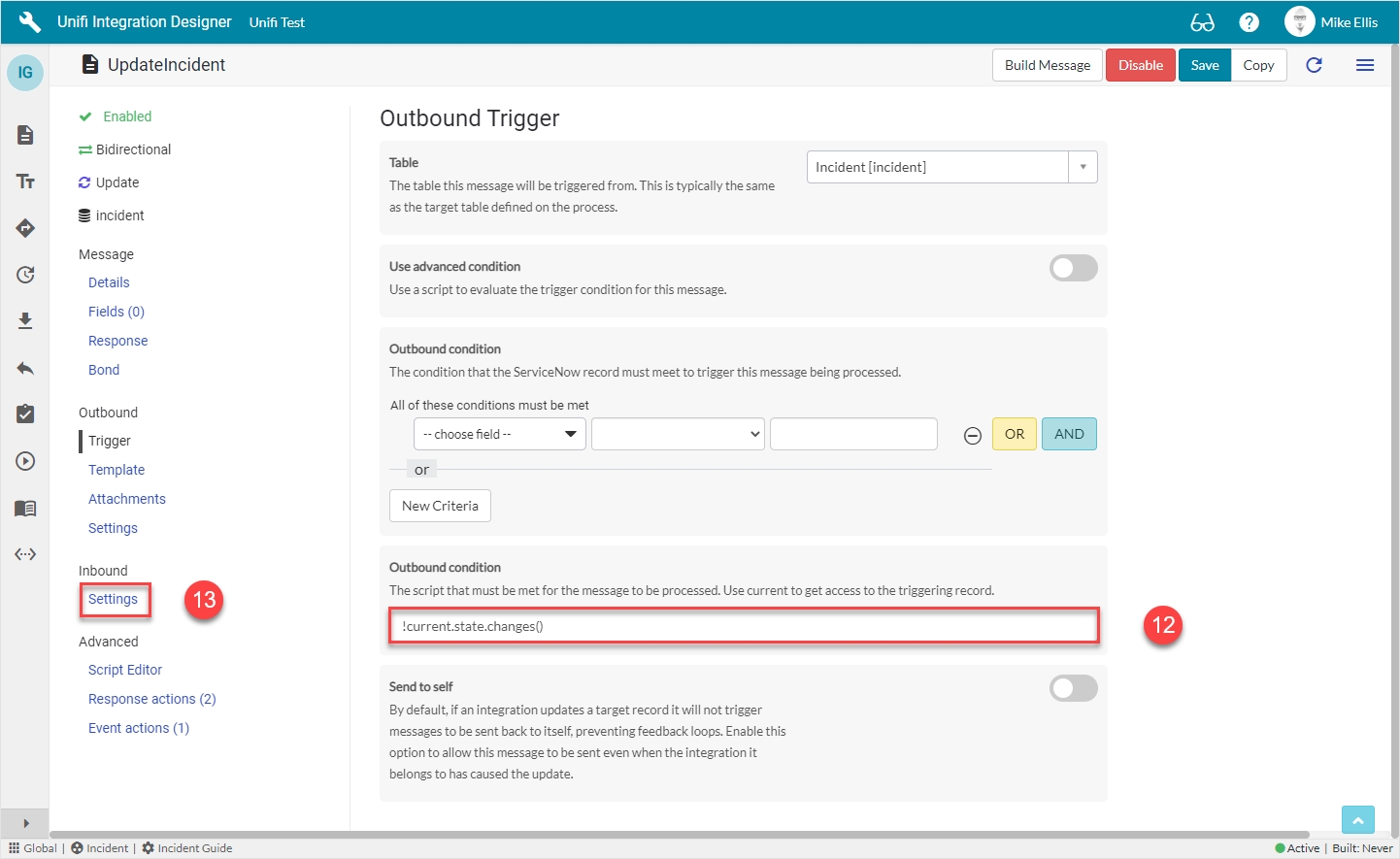
Navigate to Inbound > Settings.
Inbound Settings Fields
The Inbound Settings fields to be configured are as follows:
Bond reference method*
Method of searching for and validating an existing bond for incoming messages.
'Both'
Reference lookup script
The script containing functions for extracting internal and external references from the request payload.
Update the code in the Reference lookup script field so that it looks like the code below
As mentioned earlier, because this is an update type message, we use 'Both' as it's a more accurate method of validating updates are being sent to/received from the correct bonded records.
The code in the 'Reference lookup script' field should look like this:
Your Inbound Settings form should look like this:
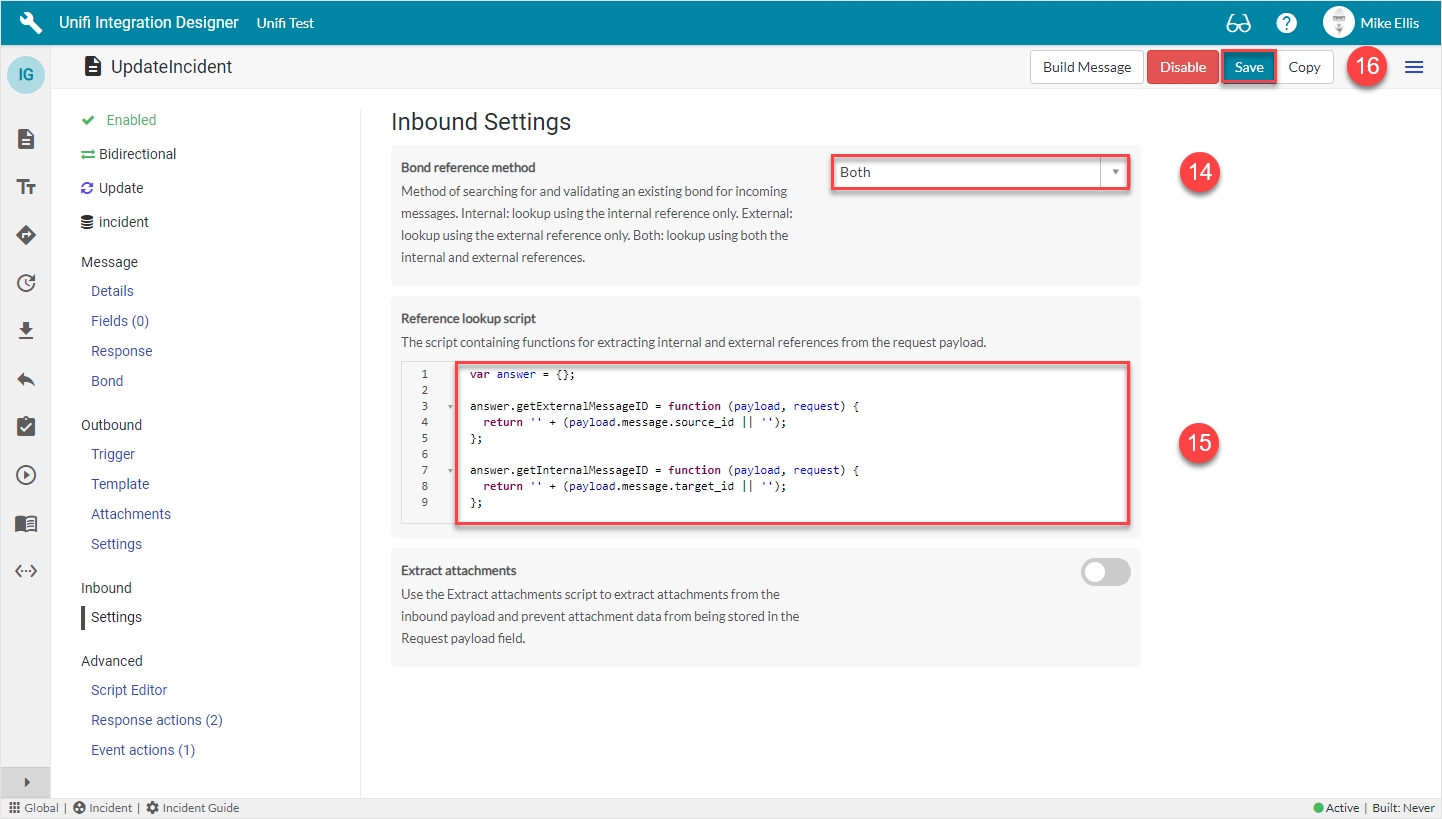
Click Save.
We are now ready to configure the Fields for our UpdateIncident Message.
UpdateIncident Fields
We will utilise the Field & Field Map records to configure the Message Scripts for the UpdateIncident Message.
Field: message.message_header
From the UpdateIncident Message, navigate to Message > Fields.
Your UpdateIncident Fields page should look like this:
Find the message.message_header (Integration level) Field & set Active to true.
The 'Build Integration' button becomes visible in the banner and the empty circle icon next to the Field name turns green & contains a green 'check' (to indicate that Message level configuration exists for this Field). Note: the empty 'circle icon' indicates that the Integration level Field is available to add to the Message.
As before, by setting the Active flag to true on the Integration level Field record listed on the Message, Unifi has automatically created the Message level counterpart.
Next, repeat the process for the incident.short_description Field.
Field: incident.short_description
Your UpdateIncident Fields page should look like this:
Find the incident.short_description (Integration level) Field & set Active to true.
The empty circle icon next to the Field name turns green & contains a green 'check' (to indicate that Message level configuration exists for this Field).
We will now configure Field records for two other Incident record field elements.
Fields & Field Maps
The table below lists the Incident record field elements we will map and the relevant Field Maps required to configure each Field record.
comments
Journal field
work_notes
Journal field
Copy Field Maps
If you haven't already, you will need to copy the relevant additional Field Maps for the UpdateIncident Field records as follows:
Journal field
See Copy Field Maps (on the 'CreateIncidentReceipt Fields' page) for details.
Field: incident.comments
From the UpdateIncident Message, navigaate to Message > Fields & click New.
The fields to be configured for our incident.comments New Field modal are as follows:
Message*
The Message this Field record is linked with.
'UpdateIncident'
Description
Describe what this field is for and any specific details that might help you in future.
'The incident's comments'
Active*
Set to true to use this Field record for processing.
<true>
Field map
The Field Map this Field record is linked with.
'IG - Journal field'**
Map to field*
Use this Field record to represent a field on a source/target table.
<true>
Table*
The primary source/target table that this Field record is mapped to.
'Incident' [incident]
Element
The field on the source/target table this Field record is mapped to.
'Additional comments'
Path
Where in the payload the data will be placed.
'detail'
Property*
The property in the payload the data will be written to.
Automatically populated
Inbound*
Set to true to use for inbound Messages.
<true>
Outbound*
Set to true to use for outbound Messages.
<true>
*These fields are automatically defaulted to true, or automatically populated.
**Field map: Value may vary. Choose the copy Field Map you created for your Integration.
Your 'incident.comments' New Field modal should look like this:
Submit the record.
You will be redirected back to the Fields page of the UpdateIncident Message.
Field: incident.work_notes
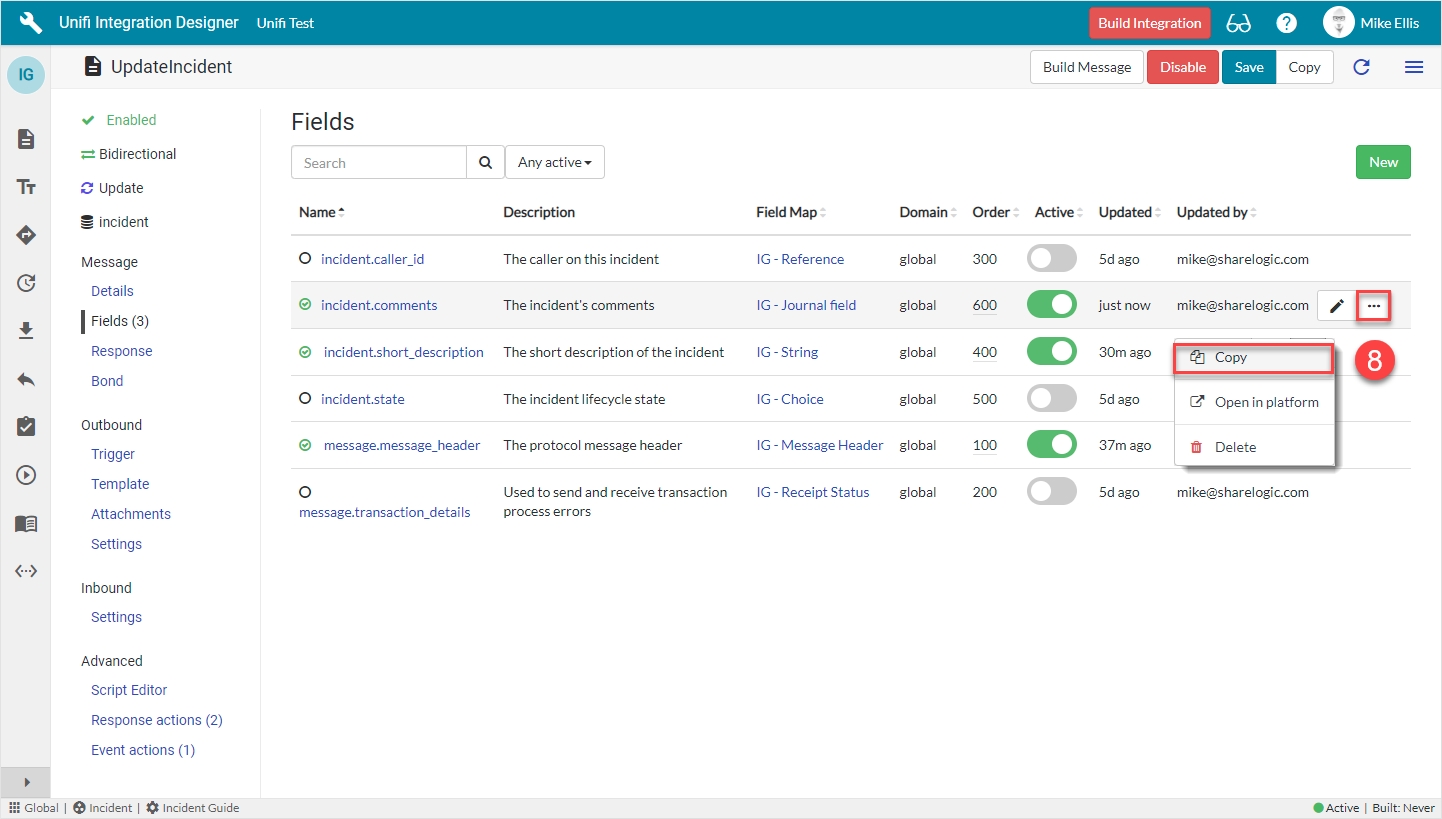
Click the ellipsis next to the incident.comments Field record & click Copy.
The fields to edit for the Copy Field modal are as follows:
Element
The field on the source/target table this Field record is mapped to.
'Work notes'
Property*
The property in the payload the data will be written to.
Automatically populated
Description
Describe what this field is for and any specific details that might help you in future.
'The incident's work notes'
*This field is automatically populated.
Your Copy Field modal should look like this:
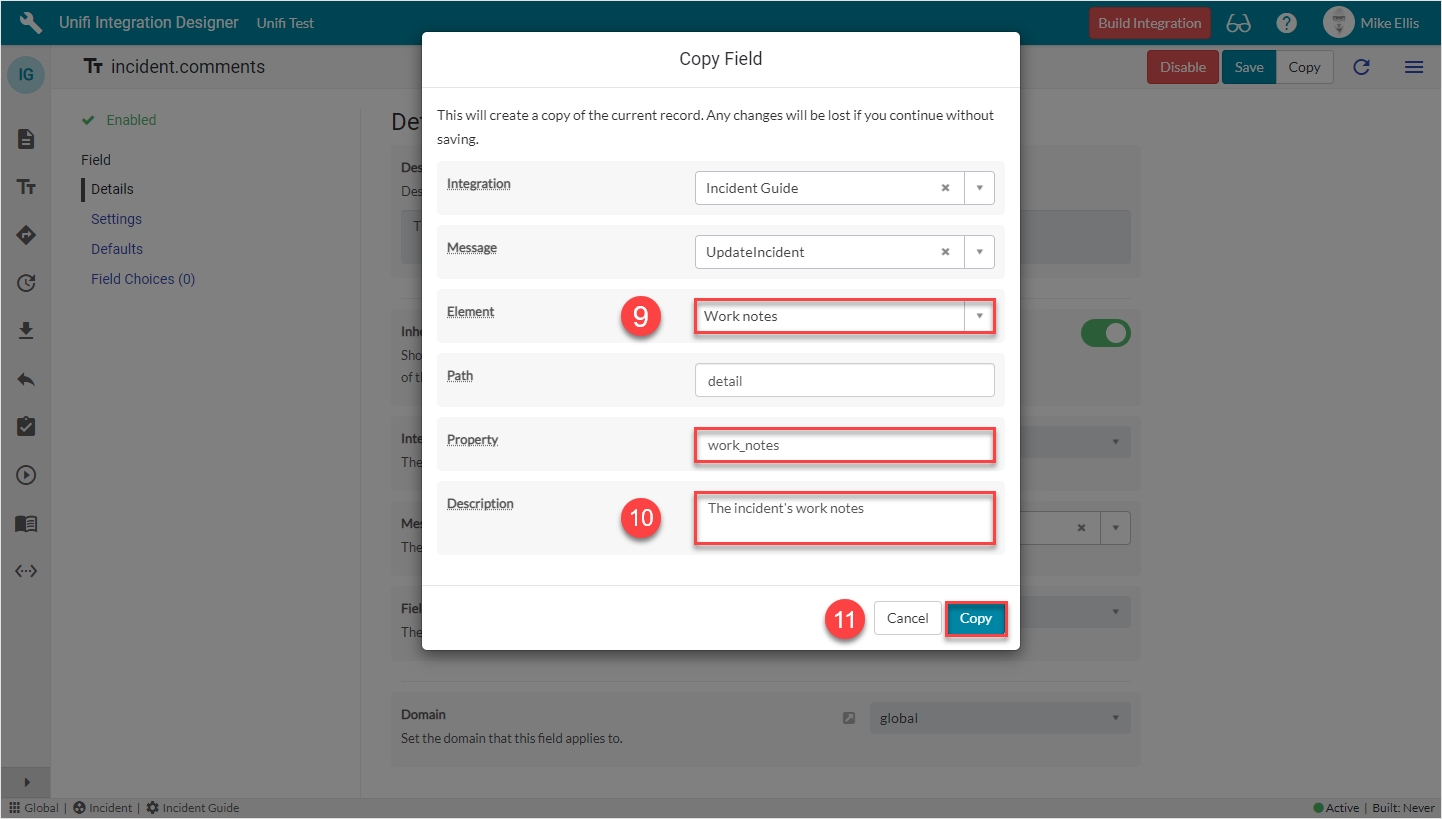
Click Copy.
You will be redirected to the Details page of the newly created incident.work_notes Field record.
Build
Now that we’ve configured the Field records for the UpdateIncident message, we are ready to build our message scripts.
To quickly navigate to the UpdateIncident Message from the Details page of the newly created incident.work_notes Field record…

...click the 'Preview' icon to the left of the Message field.
From the UpdateIncident message, navigate to Message > Fields.
The following Field records should now be in place for your UpdateIncident messsage:
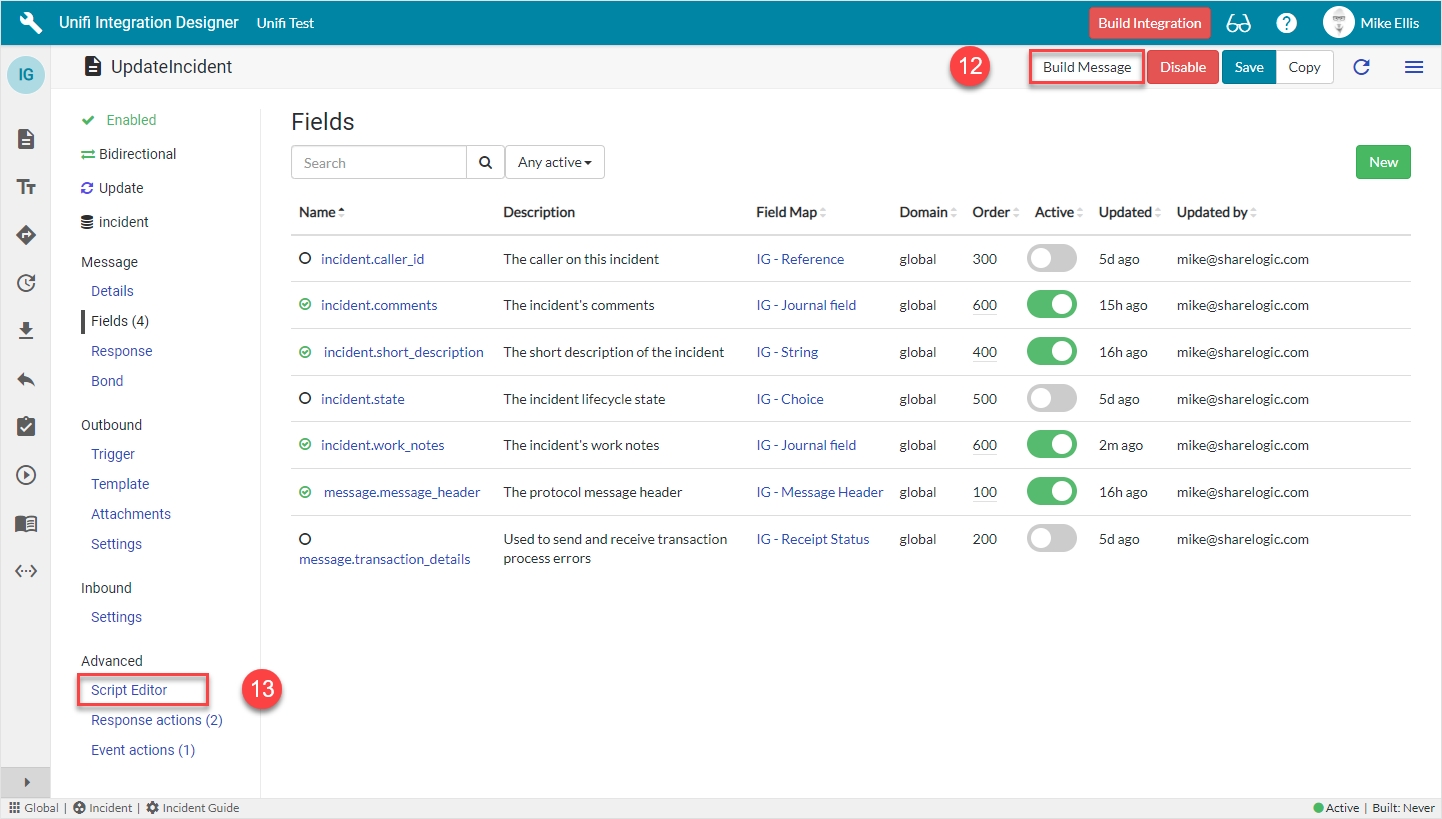
Click on Build Message.
You will see the 'Message build successful' Info Message.
Navigate to Advanced > Script Editor to view the auto-generated code.
Your Script Editor fields should look like this:
Message Scripts
We are now ready to Test our UpdateIncident Message.
Test UpdateIncident
Follow these steps to test the UpdateIncident Message.
Update the Incident
Navigate to < Your Incident > created in the previous test.
Your Incident record should look like this:
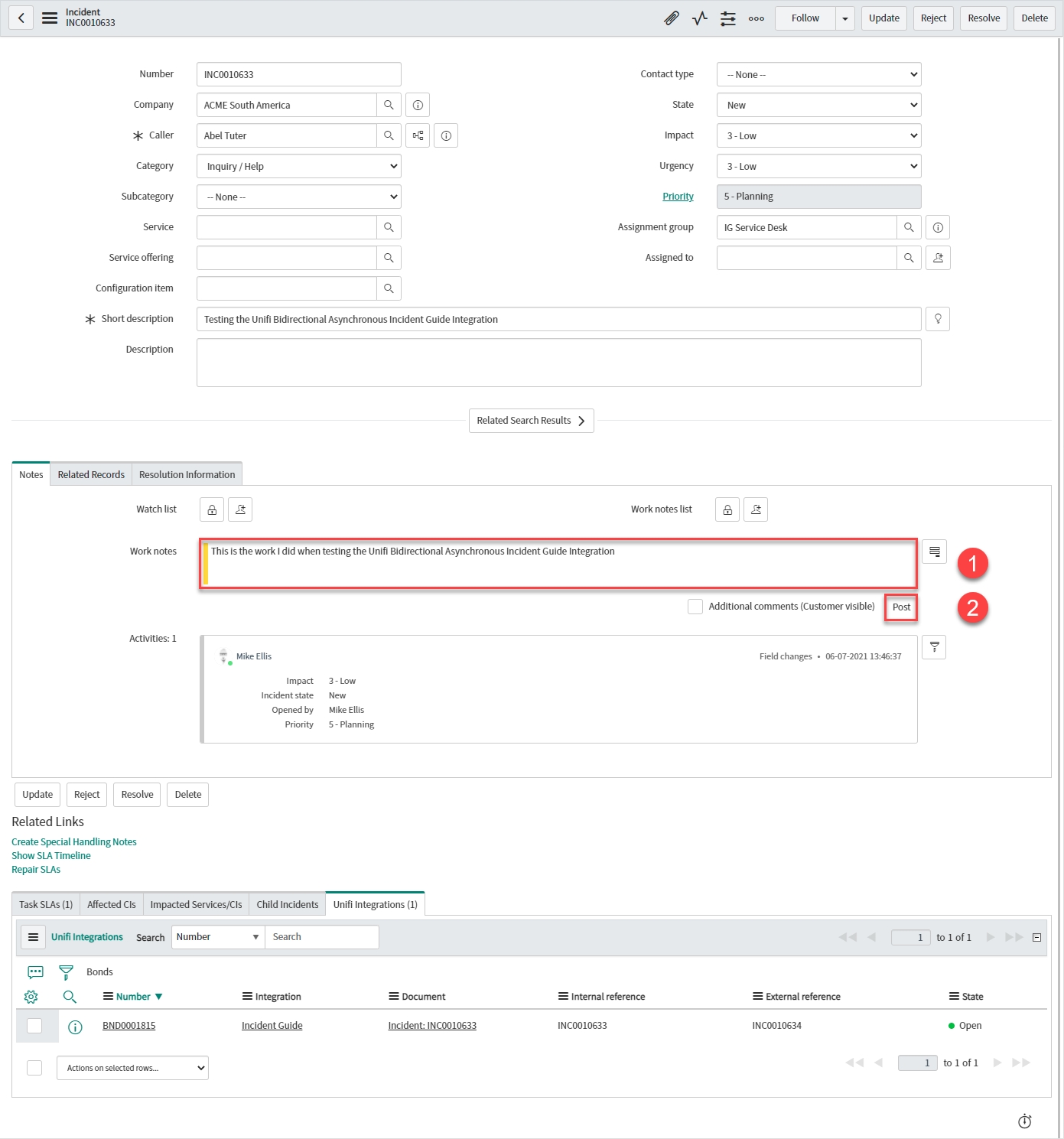
Enter < Your Work notes > in the 'Work notes' field.
Click Post.
You should see an Info Message, confirming the UpdateIncident Message is being sent to your Integration:

The Work note is added to the Activities stream on the 'Notes' tab:
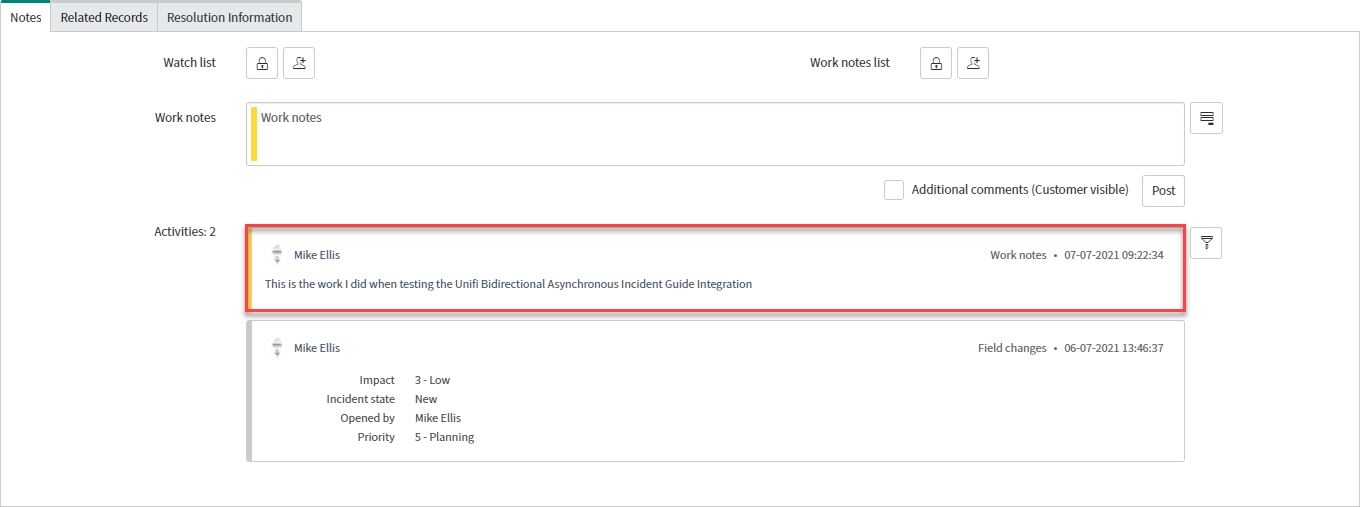
View the Bond
Click through to the Bond record from the related list on the Incident.
Your Bond record should have been updated as follows:
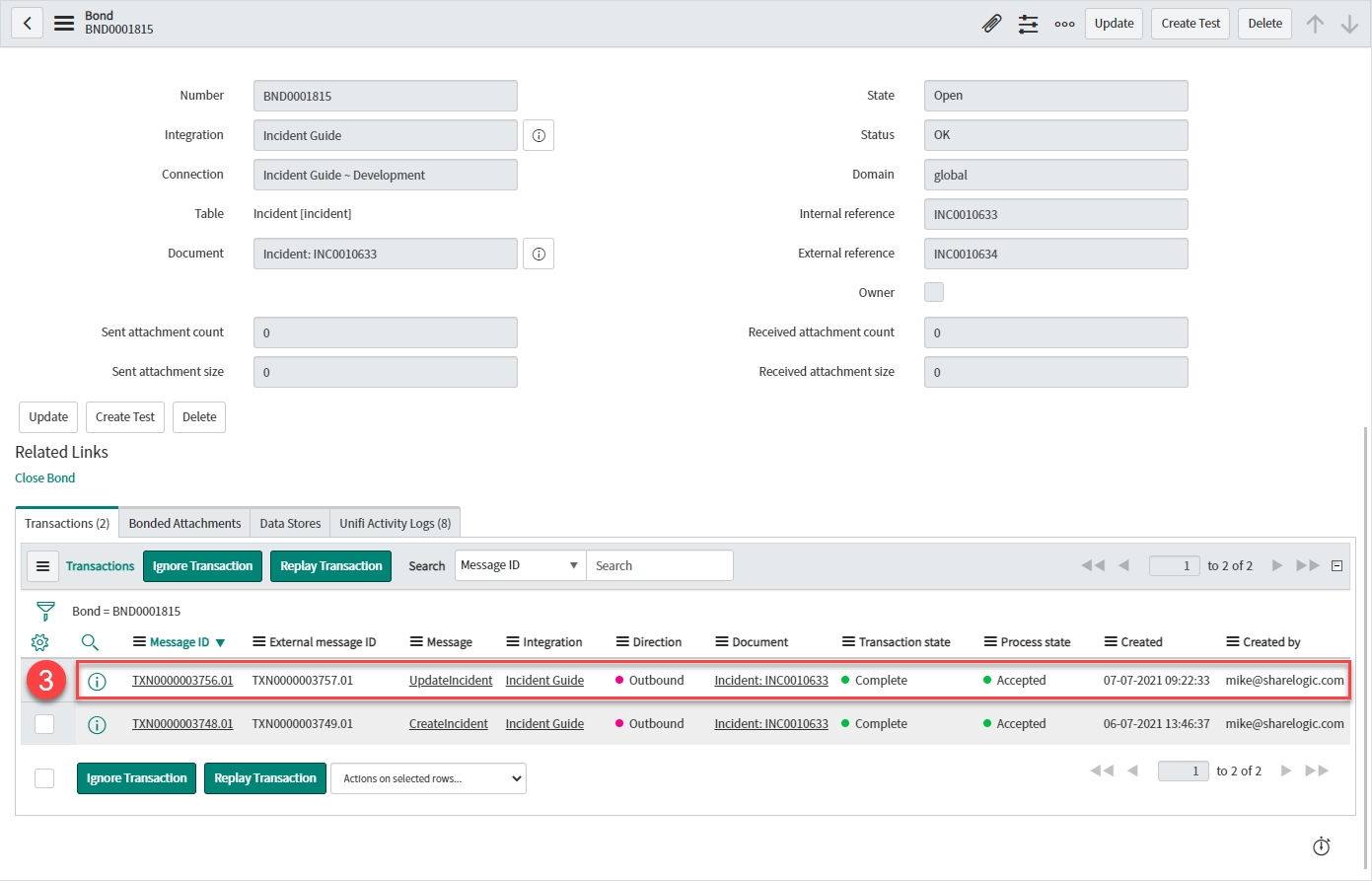
Transaction:
Message: 'Updateincident'
Direction: 'Outbound'
Transaction state: 'Complete' (The data has been successfully transported)
Process state: 'Accepted' (The transaction was accepted as within the scope of the business logic that's in place)
View the Transaction
Click through to the Transaction record from the related list on the Bond.
Your Transaction record should look like this:
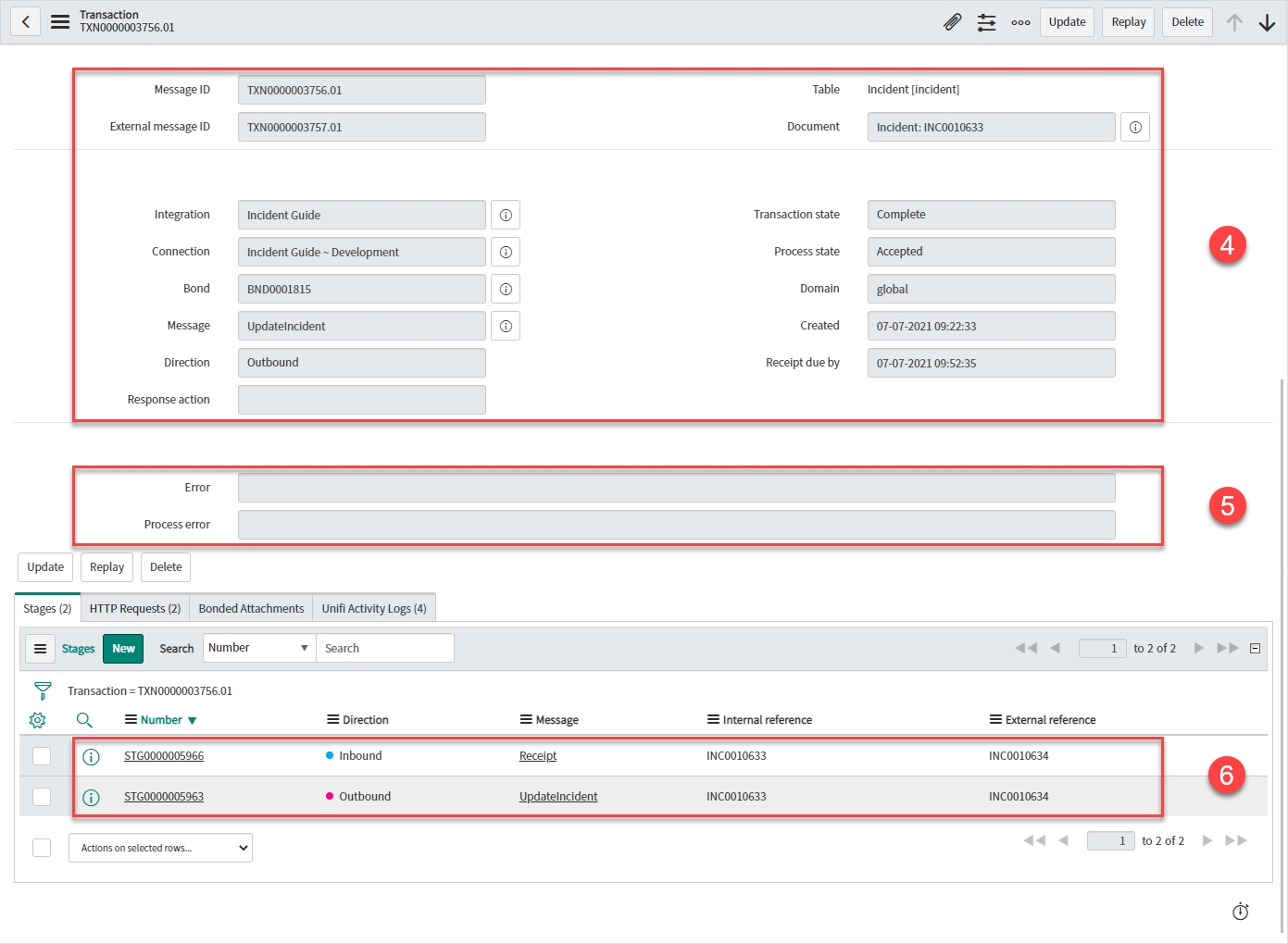
Transaction details:
Table: 'Incident [incident]'
Document: < Your Incident >
Integration: < Your Integration >
Connection: < Your Connection >
Bond: < Your Bond >
Message: 'UpdateIncident'
Direction: 'Outbound'
Transaction state: 'Complete' (The data has been successfully transported)
Process state: 'Accepted' (The transaction was accepted as within the scope of the business logic that's in place)
Errors:
Error: (If there was a transactional error the Transaction state would show as 'Error' and the details would be captured here).
Process error: (If there was a process error the Process state would show as 'Rejected' and the details would be captured here)
Stages:
Direction: 'Outbound' & 'Inbound'
Message: 'UpdateIncident' & 'Receipt'
Internal reference: < ServiceNow ticket reference > (Same as 'Document')
External reference: < External system's ticket reference >
View the Stage
Click through to the Outbound Stage record from the related list on the Transaction. (If you wish, you could also do the same for the Inbound Stage record.)
Check the values in the fields match what you expect.
Your Stage record should look like this:
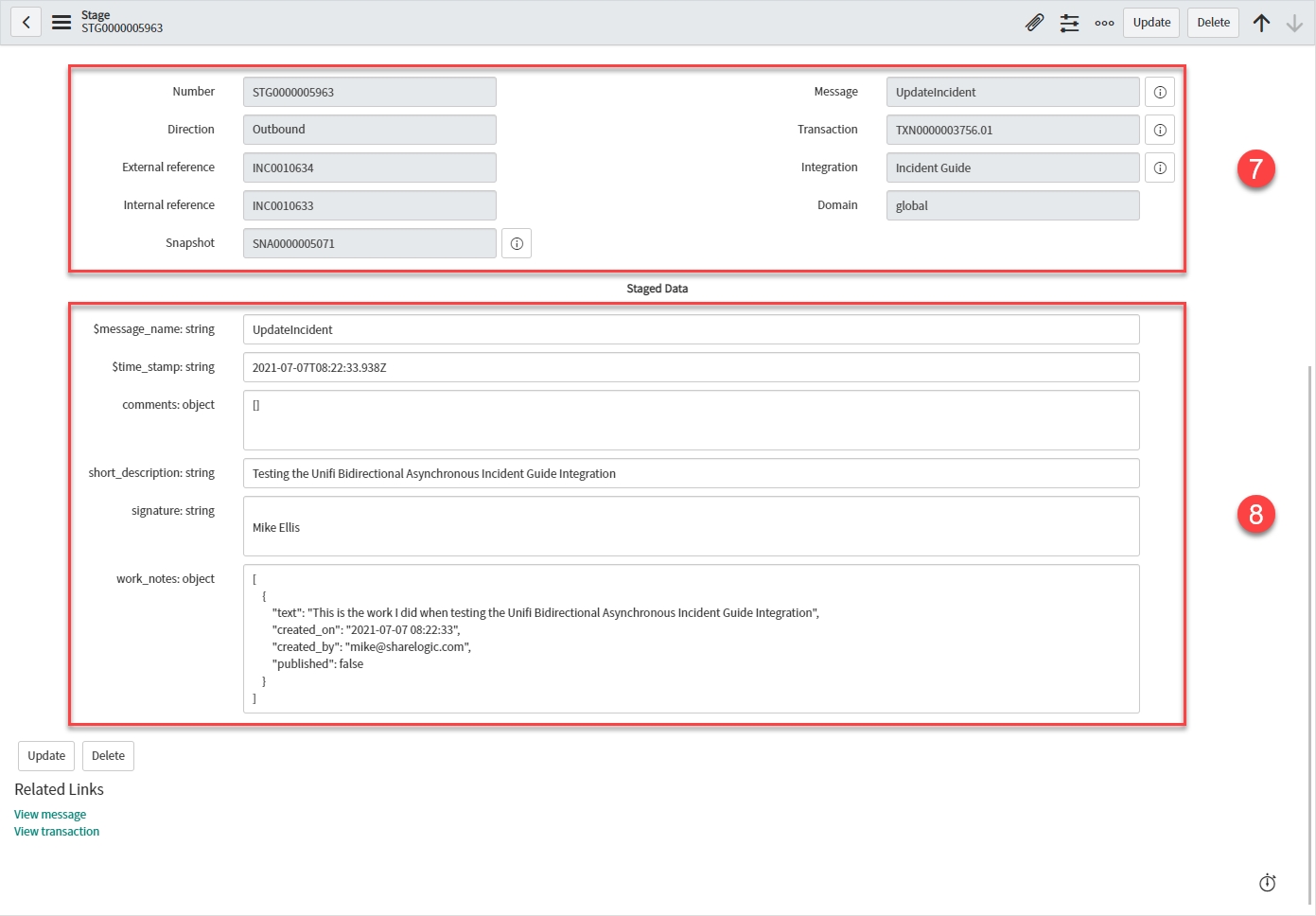
Stage details:
Direction: 'Outbound'
External reference: < External system's ticket reference >
Internal reference: < ServiceNow ticket reference >
Snapshot: < Snapshot record reference >
Message: 'UpdateIncident'
Transaction: < Your Transaction >
Integration: < Your Integration >
Mapped Staged Data fields:
work_notes: < Your Work note >
View the HTTP Request
Click through to the Outbound HTTP Request record from the related list on the Transaction. (If you wish, you could also do the same for the Inbound HTTP Request record.)
Your HTTP Request record should look like this:
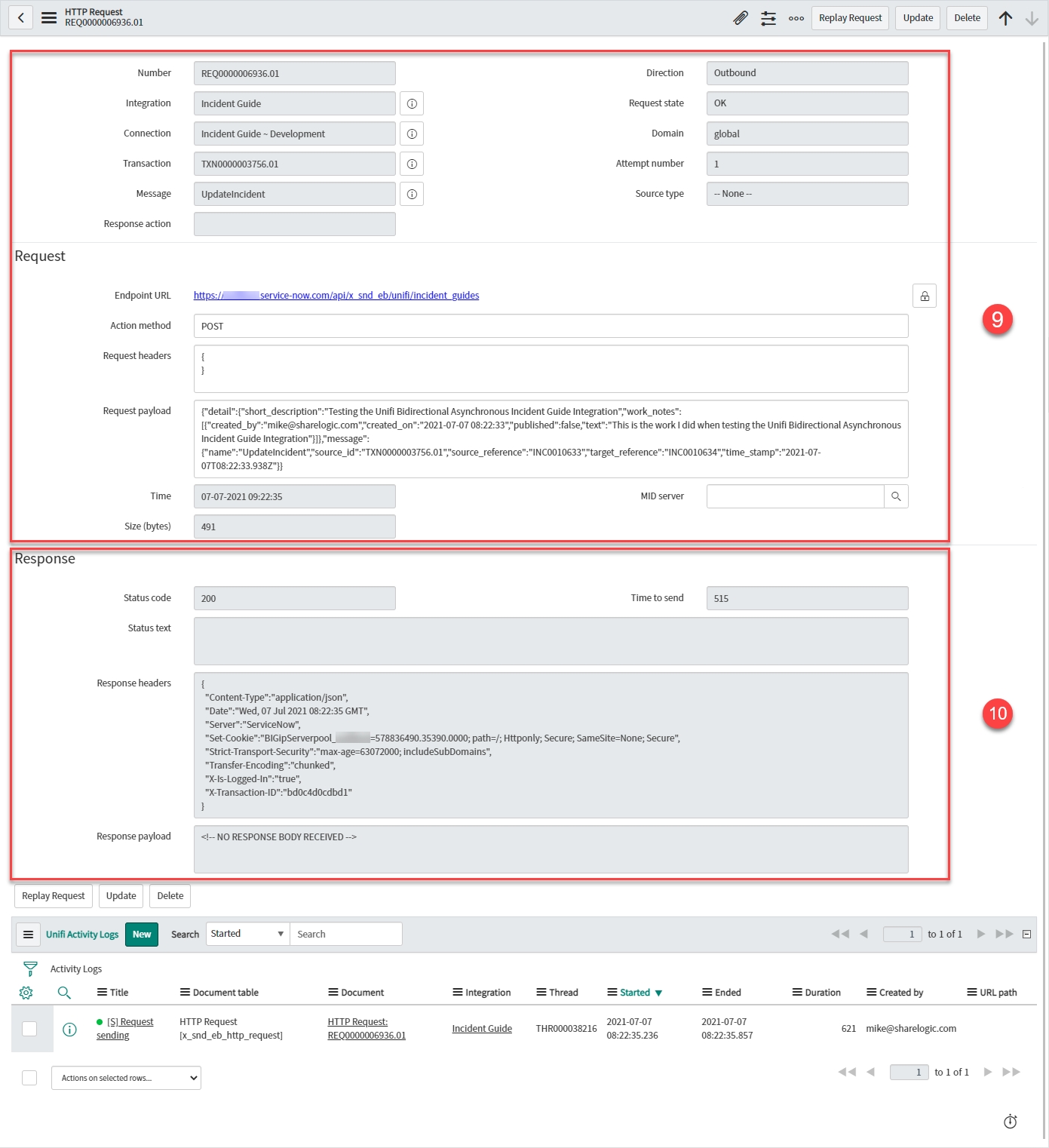
HTTP Request details:
Integration: < Your Integration >
Connection: < Your Connection >
Transaction: < Your Transaction >
Message: 'UpdateIncident'
Direction: 'Outbound'
Request state: 'OK' (There are no errors with the HTTP Request.)
Attempt number: < Number of HTTP Request attempts > (Failed requests are retried up to the maximum attempts number as configured on the Integration.)
Endpoint URL: < The external system’s access URL >
Action Method: 'POST'
Request headers: < The header of the request being sent >
Request payload: < The payload of the request being sent >
Response details:
Status code: '200'
Response headers: < The header of the response being received >
Response payload: < The payload of the response being received >
Compare with the External System's Incident
Navigate to the corresponding Incident in the external system.
Check the values in the fields match those you noted when you saved the Incident in the internal system.
Your external system's Incident record should look like this (depending on the system you're integrating with, your record may look different; the important matter is that the values match):
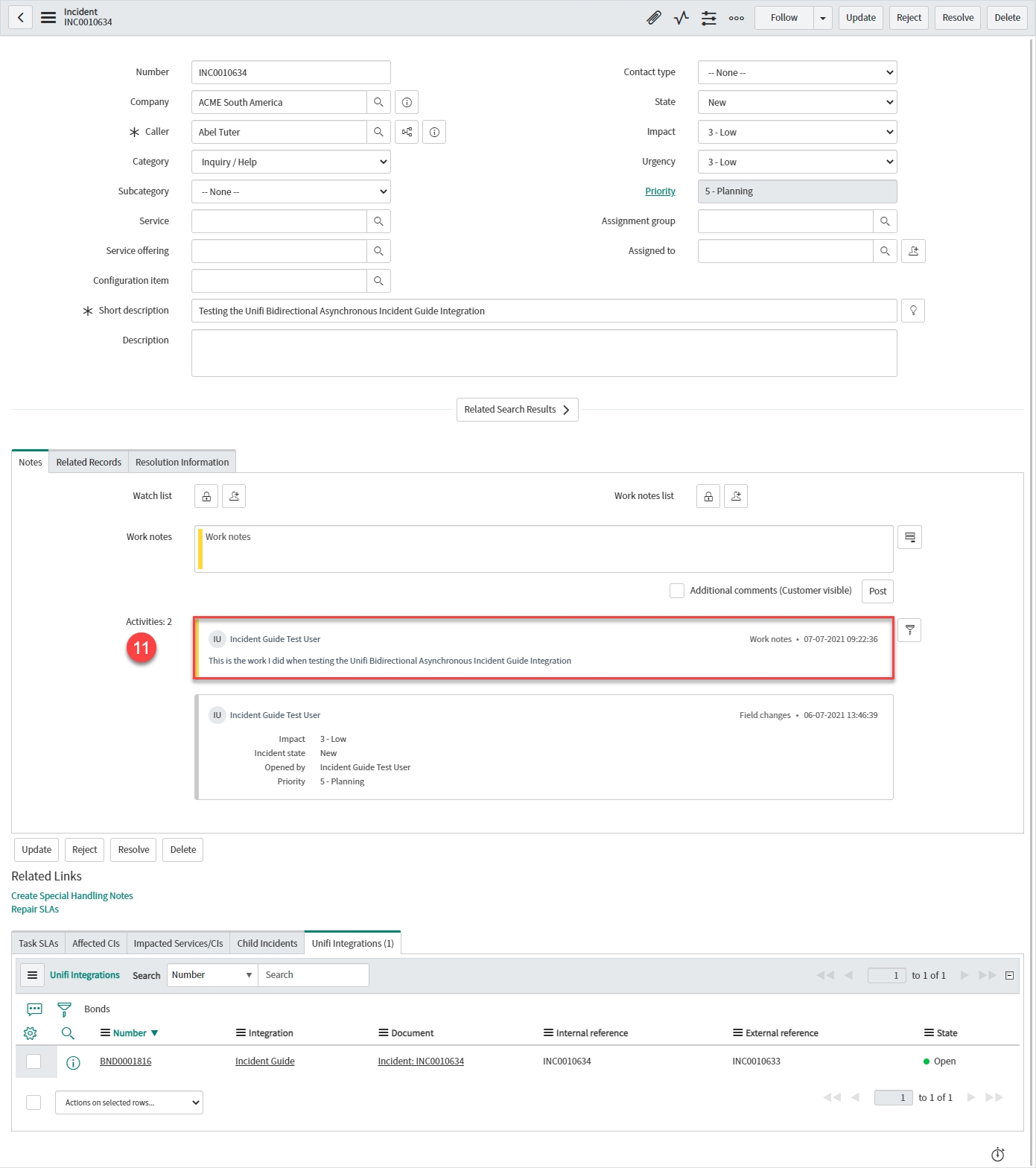
Activities: < Your Work note > (added by < your.external.system.user >)
Challenge
Repeat the steps above - this time placing a check in the 'Additional comments (Customer visible)' checkbox.
What do you expect to happen?
As when testing our CreateIncident Message, if completing this test after having integrated with the external system (as opposed to connecting to your own instance), it would be good to test the UpdateIncident Message in both directions.
We are now ready to move to the Resolve Scenario.